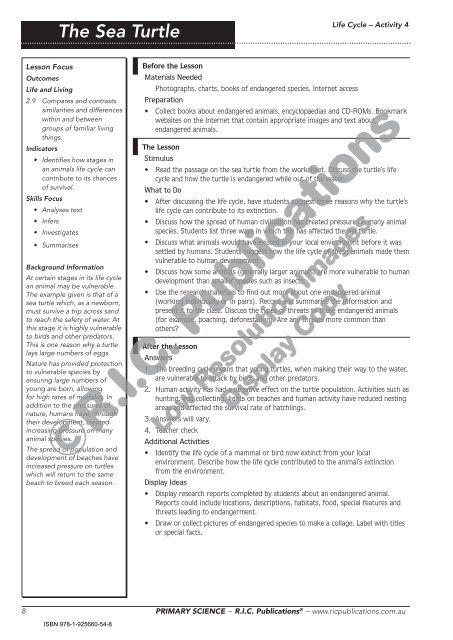RIC-3531 Primary Science - Book D (Digital)
You also want an ePaper? Increase the reach of your titles
YUMPU automatically turns print PDFs into web optimized ePapers that Google loves.
The Sea Turtle<br />
Life Cycle – Activity 4<br />
Lesson Focus<br />
Outcomes<br />
Life and Living<br />
2.9 Compares and contrasts<br />
similarities and differences<br />
within and between<br />
groups of familiar living<br />
things.<br />
Indicators<br />
• Identifies how stages in<br />
an animals life cycle can<br />
contribute to its chances<br />
of survival.<br />
Skills Focus<br />
• Analyses text<br />
• Infers<br />
• Investigates<br />
• Summarises<br />
Background Information<br />
At certain stages in its life cycle<br />
an animal may be vulnerable.<br />
The example given is that of a<br />
sea turtle which, as a newborn,<br />
must survive a trip across sand<br />
to reach the safety of water. At<br />
this stage it is highly vulnerable<br />
to birds and other predators.<br />
This is one reason why a turtle<br />
lays large numbers of eggs.<br />
Nature has provided protection<br />
to vulnerable species by<br />
ensuring large numbers of<br />
young are born, allowing<br />
for high rates of mortality. In<br />
addition to the pressures of<br />
nature, humans have, through<br />
their development, created<br />
increasing pressure on many<br />
animal species.<br />
The spread of population and<br />
development of beaches have<br />
increased pressure on turtles<br />
which will return to the same<br />
beach to breed each season.<br />
Before the Lesson<br />
Materials Needed<br />
Photographs, charts, books of endangered species, Internet access<br />
Preparation<br />
• Collect books about endangered animals, encyclopaedias and CD-ROMs. <strong>Book</strong>mark<br />
websites on the Internet that contain appropriate images and text about<br />
endangered animals.<br />
The Lesson<br />
Stimulus<br />
• Read the passage on the sea turtle from the worksheet. Discuss the turtle’s life<br />
cycle and how the turtle is endangered while out of the water.<br />
What to Do<br />
• After discussing the life cycle, have students suggest three reasons why the turtle’s<br />
life cycle can contribute to its extinction.<br />
• Discuss how the spread of human civilisation has created pressure on many animal<br />
species. Students list three ways in which this has affected the sea turtle.<br />
• Discuss what animals would have existed in your local environment before it was<br />
settled by humans. Students suggest how the life cycle of these animals made them<br />
vulnerable to human development.<br />
• Discuss how some animals (generally larger animals) are more vulnerable to human<br />
development than smaller species such as insects.<br />
• Use the research materials to find out more about one endangered animal<br />
(working individually or in pairs). Record and summarise the information and<br />
present it to the class. Discuss the types of threats to these endangered animals<br />
(for example, poaching, deforestation). Are any threats more common than<br />
others?<br />
After the Lesson<br />
Answers<br />
1. The breeding cycle means that young turtles, when making their way to the water,<br />
are vulnerable to attack by birds and other predators.<br />
2. Human activity has had a negative effect on the turtle population. Activities such as<br />
hunting, egg collecting, lights on beaches and human activity have reduced nesting<br />
areas and affected the survival rate of hatchlings.<br />
3. Answers will vary.<br />
4. Teacher check<br />
Additional Activities<br />
• Identify the life cycle of a mammal or bird now extinct from your local<br />
environment. Describe how the life cycle contributed to the animal’s extinction<br />
from the environment.<br />
Display Ideas<br />
• Display research reports completed by students about an endangered animal.<br />
Reports could include locations, descriptions, habitats, food, special features and<br />
threats leading to endangerment.<br />
• Draw or collect pictures of endangered species to make a collage. Label with titles<br />
or special facts.<br />
©R.I.C. Publications<br />
Low Resolution Images<br />
Display Copy<br />
8 PRIMARY SCIENCE ~ R.I.C. Publications ® ~ www.ricpublications.com.au<br />
ISBN 978-1-925660-54-8


















